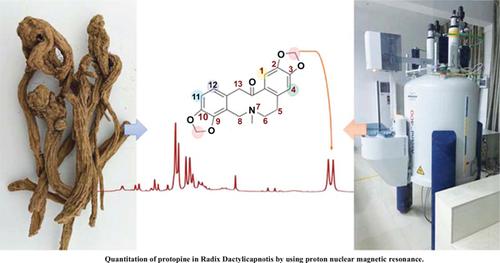质子核磁共振定量法测定丁香中丙氨酸的含量
IF 1.5
4区 医学
Q4 PHARMACOLOGY & PHARMACY
引用次数: 0
摘要
白族草本植物,即番木瓜科的根和块茎,具有清热止痛、止血降压的功效。本研究旨在建立一种用质子核磁共振(1H NMR)光谱法定量测定Dactylicapnotis中原松含量的方法。对氘溶剂、内标物和核磁共振参数进行了优化。该定量方法通过线性、精密度、准确度、重复性和稳定性以及检测限(LOD)和定量限(LOQ)测定进行了验证。由500μL DMSO-d6和20μL D2O组成的混合溶液能够令人满意地分离要整合到1H NMR光谱中的信号。选择1,3,5-三羧酸三甲乙酯(TMBT)作为内标。选择对应于OCH2O的δ6.05–6.08的积分来量化原松。所开发的定量方法被发现是精确和准确的,并且显示出良好的线性和范围。利用该特征信号可以准确地定量Dactylicapnotis中protopine的含量。本研究首次报道了用1H NMR定量测定钩藤中原松的含量。研究结果表明,定量1H NMR是一种可行的替代高效液相色谱法测定钩针药材中原松含量的方法,适用于钩针药材的质量控制。本文章由计算机程序翻译,如有差异,请以英文原文为准。

Application of a Quantitative Proton Nuclear Magnetic Resonance Method for the Determination of Protopine in Radix Dactylicapnotis
The Bai ethnologic herb Radix Dactylicapnotis, the root and tuber of Dactylicapnos scandens (Papaveraceae), is used for clearing heat, relieving pain, and achieving hemostasis and antihypertensive effects.
The study aimed to develop a quantitative method for determining the protopine content in Radix Dactylicapnotis by using proton nuclear magnetic resonance (1H NMR) spectroscopy.
The deuterium solvent, internal standard, and NMR parameters were optimized. The quantitative method was validated by linearity, precision, accuracy, repeatability, and stability, as well as limit-of-detection (LOD) and limit-of-quantitation (LOQ) assays.
A mixture solution consisting of 500 μL of DMSO-d6 and 20 μL of D2O enabled satisfactory separation of the signals to be integrated into the 1H NMR spectrum. Trimethyl benzene-1,3,5-tricarboxylate (TMBT) was selected as an internal standard. The integration of δ 6.05–6.08 corresponding to OCH2O was selected to quantify protopine. The developed quantitative method was found to be precise and accurate and to exhibit excellent linearity and range. The protopine content in Radix Dactylicapnotis could be quantified accurately using the featured signal.
This is the first study to report quantitative 1H NMR determination of protopine in Radix Dactylicapnotis. The study results indicate that quantitative 1H NMR represents a feasible alternative to HPLC-based methods for the quantitation of protopine in Radix Dactylicapnotis, and is suitable for the quality control of Radix Dactylicapnotis.
求助全文
通过发布文献求助,成功后即可免费获取论文全文。
去求助
来源期刊
CiteScore
1.50
自引率
0.00%
发文量
85
审稿时长
3 months
期刊介绍:
Aims & Scope
Current Pharmaceutical Analysis publishes expert reviews and original research articles on all the most recent advances in pharmaceutical and biomedical analysis. All aspects of the field are represented including drug analysis, analytical methodology and instrumentation. The journal is essential to all involved in pharmaceutical, biochemical and clinical analysis.

 求助内容:
求助内容: 应助结果提醒方式:
应助结果提醒方式:


